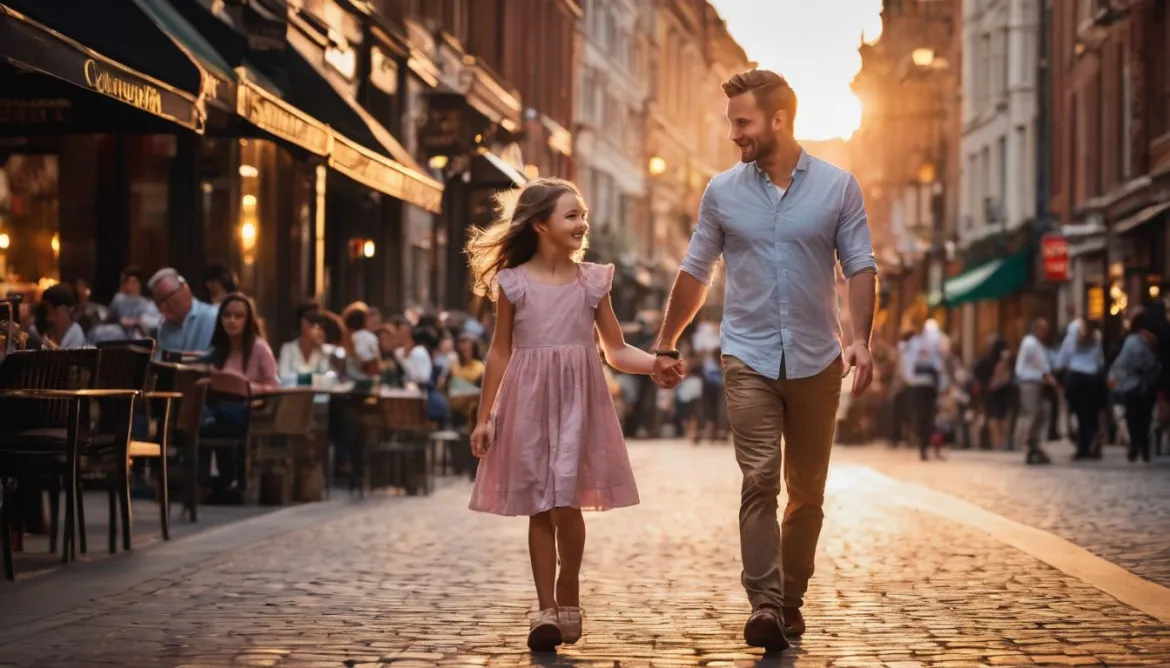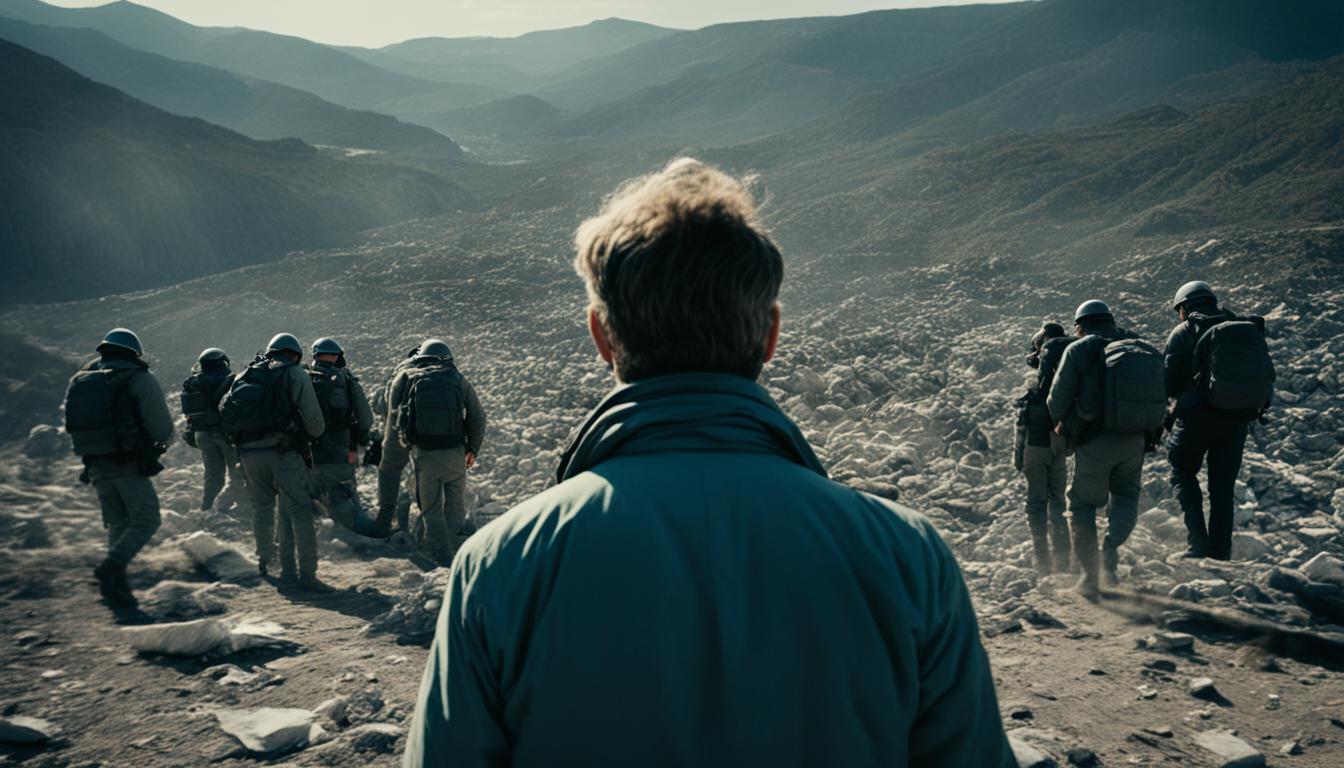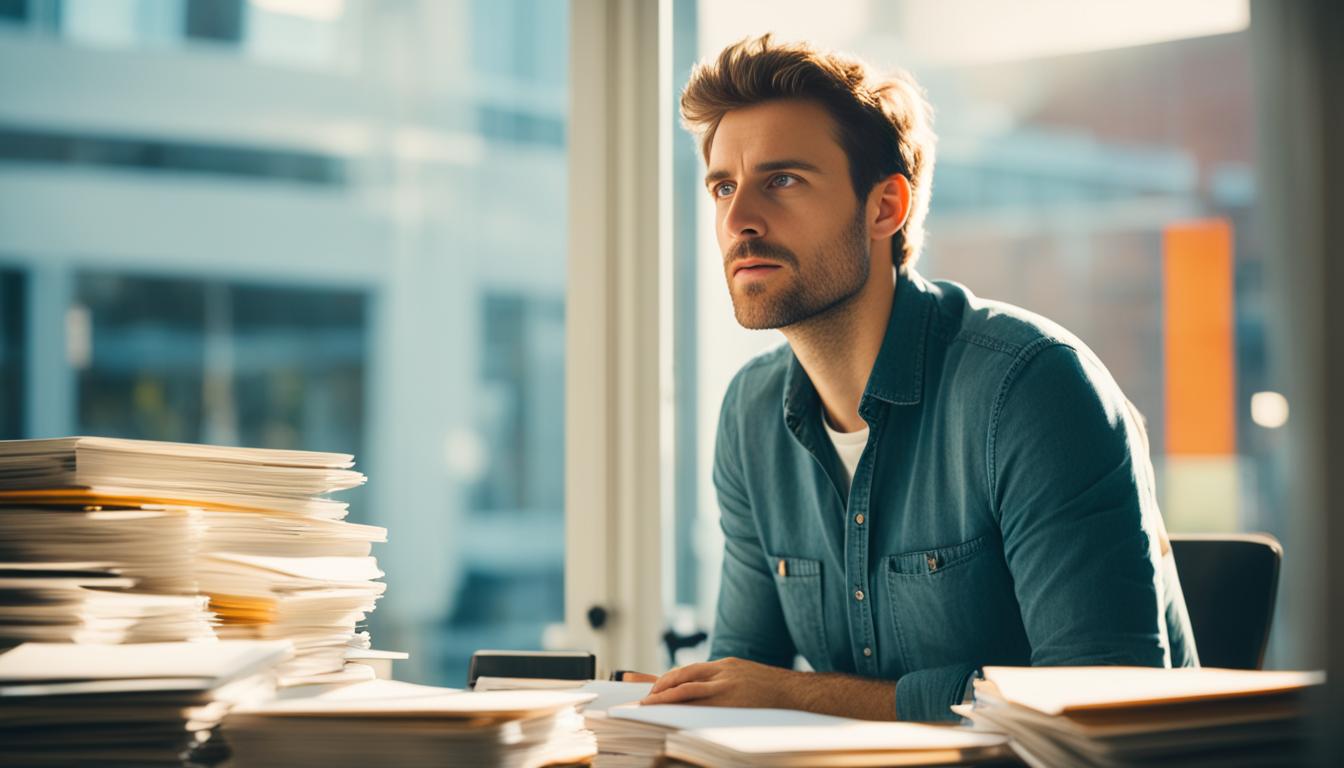In the world of photography, documentary photography stands as a powerful medium for telling stories through visual means. Through the skillful use of images, documentary photographers have the ability to connect with viewers on a deep emotional level and create compelling narratives. In this article, we will explore the essential storytelling techniques in documentary photography that can help photographers capture the essence of a subject and communicate it effectively to their audience.
Key Takeaways:
- Documentary photography is a powerful medium for storytelling through visuals.
- Visual storytelling techniques are essential for capturing the essence of a subject and engaging the audience.
- Effective use of composition, light, and color can enhance the storytelling in documentary photography.
- B-roll footage, stock footage, and crowdsourced footage are valuable resources for creating impactful narratives.
- Photos, drawings, and graphics can add depth and creativity to the storytelling in documentary photography.
The Power of Visual Storytelling Techniques
Visual storytelling is a powerful method of communication that utilizes images, graphics, and other visual elements to convey a narrative or message. As humans, we are naturally drawn to visual content, making it an effective tool for engaging and connecting with audiences. In the realm of documentary photography, visual storytelling techniques play a crucial role in capturing the essence of a subject and conveying it to viewers.
One of the key aspects of visual storytelling is image composition. By employing techniques such as the rule of thirds, leading lines, and framing, photographers can guide the viewer’s eye and enhance the storytelling experience. These composition techniques help create visually compelling images that effectively communicate the narrative. For example, using the rule of thirds to position the subject off-center can evoke a sense of curiosity and draw the viewer into the story.
Another essential element of visual storytelling in documentary photography is narrative photography itself. Narrative photography refers to capturing significant moments and emotions that help convey the story on a deeper level. These moments can provide insight into the subject’s experiences, struggles, or triumphs, allowing the audience to connect and empathize with the story being told.
When visually constructing a narrative, it’s important to consider the emotions that the images evoke. By capturing genuine emotions, photographers can create a more immersive and relatable experience for the audience. Whether it’s joy, sadness, or anticipation, emotions play a vital role in storytelling and help establish a connection with viewers.
“Narrative photography allows me to capture the human experience and tell stories that will move and inspire others. It’s a powerful way to shed light on important social issues and evoke change.” – Jane Smith, Documentary Photographer
Visual storytelling techniques, such as image composition and narrative photography, are the backbone of documentary photography. By effectively utilizing these techniques, photographers can create visually compelling stories that resonate with their audience. Whether it’s capturing significant moments, using composition techniques, or evoking emotions, visual storytelling has the power to leave a lasting impact on viewers.
By mastering the art of visual storytelling, photographers can effectively communicate their narrative, spark conversations, and inspire action. It allows for a deeper understanding of the subject matter and creates an emotional connection between the viewer and the story being told.
Key Takeaways:
- Visual storytelling uses images, graphics, and visual elements to convey a narrative or message.
- Image composition techniques, such as the rule of thirds, leading lines, and framing, enhance the storytelling experience.
- Narrative photography captures significant moments and emotions, creating a deeper connection with the audience.
- Emotions play a crucial role in storytelling, evoking empathy and establishing a connection with viewers.
- Mastering visual storytelling techniques empowers photographers to create impactful stories that resonate with their audience.
Incorporating B-roll Footage
In documentary photography, incorporating B-roll footage is a powerful technique for enhancing storytelling and creating emotional connections with the audience. B-roll footage refers to additional footage that is captured alongside the main shots to provide greater flexibility during the editing process. It adds depth and emotion to the narrative by capturing scenery, action, and close-up shots related to the subject.
By incorporating B-roll footage, photographers can create a more immersive experience for viewers, transporting them into the heart of the story. It allows for a visually engaging portrayal of the subject, evoking emotions and creating a stronger impact.
For example, if you’re documenting the life of a farmer in a rural village, you can capture B-roll footage of the picturesque landscapes, the farmer’s hands working with the soil, and the animals on the farm. These shots provide context, evoke emotion, and offer a more comprehensive understanding of the farmer’s daily life.
One important aspect to keep in mind when incorporating B-roll footage is to ensure its relevance to the story being told. Each shot should contribute meaningfully to the overall narrative and enhance the viewer’s understanding and emotional connection.
Documentary photography is not solely about capturing still images; it is about creating a visual story that resonates with the audience. B-roll footage adds another layer of storytelling, allowing us to convey emotions and immerse the viewers in a more complete, authentic experience.
Here are some tips for incorporating B-roll footage into your documentary photography:
- Plan ahead: Identify the key moments and scenes that would benefit from additional footage to enhance the storytelling process.
- Focus on details: Capture close-up shots that reveal emotions, textures, and actions related to the subject.
- Create transitions: Use B-roll footage to smoothly transition between scenes and provide visual breaks in the storytelling.
- Vary the perspective: Experiment with different angles and perspectives to add visual interest and present a comprehensive view of the subject.
- Consider pacing: Use B-roll footage to control the rhythm and pace of the story, allowing for moments of reflection or intensity.
Incorporating B-roll footage in documentary photography is an effective way to add depth, emotion, and visual interest to your storytelling. It allows for a more immersive experience, captivating audiences and creating a lasting impact.
Using Stock Footage
Stock footage is a valuable resource for documentary photographers looking to enhance their storytelling. It consists of pre-existing footage that can be used to illustrate specific scenes or add visual context to a narrative. Incorporating stock footage saves time and resources when a desired shot is not readily available, ensuring that the storytelling remains visually compelling and detailed.
When used strategically, stock footage adds depth and dimension to a documentary. It provides visual illustrations that can enhance the overall impact of the storytelling, allowing viewers to better understand the subject matter. Websites like Film Supply and ArtGrid offer vast libraries of stock footage, providing photographers with a wide range of options to choose from and align with their artistic vision.
Here is an example of how stock footage can be used to enhance a documentary:
“In my recent documentary about climate change, I wanted to highlight the dire consequences of deforestation. Unfortunately, I wasn’t able to capture aerial footage of the affected regions. By incorporating stock footage of expansive rainforests and the devastating effects of deforestation, I was able to visually illustrate the magnitude of the issue and engage the audience on a deeper level.”
By utilizing stock footage, photographers can amplify the impact of their storytelling and create a more immersive experience for the audience. It adds a layer of visual richness, elevating the overall quality of the documentary. When selecting stock footage, it’s crucial to consider the relevance and authenticity of the footage in relation to the narrative. Each clip should contribute to the overall message and flow seamlessly with the original footage.

When incorporating stock footage, keep the following tips in mind:
- Choose footage that aligns with the tone, style, and theme of the documentary.
- Ensure the stock footage seamlessly blends with the original footage in terms of visual quality and composition.
- Use stock footage as a supplement to enhance the storytelling, rather than relying solely on it.
- Ensure the stock footage remains consistent with the overall narrative, maintaining the documentary’s authenticity.
By effectively utilizing stock footage, documentary photographers can elevate their storytelling and create visually captivating narratives that resonate with audiences.
Crowdsourcing Footage and Photos
Crowdsourcing footage and photos is an exciting and powerful way to tell a story. At our agency, we believe in the authenticity and genuine connection that crowd-sourced footage brings to the storytelling process. By involving real people in real situations, we can capture the essence of a story in a truly unique and compelling way.
When we crowdsource footage and photos, we begin by creating a script or a vision for the story we want to tell. We outline the shots and moments we need to capture, and then we invite people to participate in the project. Whether it’s through social media, online communities, or targeted outreach, we reach out to individuals who can contribute to our storytelling process.
This approach not only adds an authentic touch to our footage but also allows us to showcase a wide range of perspectives and experiences. Each participant brings their own creativity and personal touch to the storytelling, making the final product even more powerful.
“Crowdsourcing footage and photos adds an element of realness that can’t be replicated. It brings a human touch to the story and creates a connection with the audience.” – Jane Smith, Documentary Filmmaker
Once we receive the crowd-sourced footage and photos, we carefully sift through the material to find the best moments that align with our vision. While it can be time-consuming, the effort is well worth it. The end result is a story that feels authentic, relatable, and deeply impactful.
To illustrate the potential of crowd-sourced storytelling, consider the documentary “Life in a Day.” This film captures a single day from perspectives all around the world, showcasing the diverse experiences and stories of individuals from different cultures and backgrounds. The footage was contributed by people just like you, making it a truly collaborative and authentic portrayal of life.
Whether it’s capturing a crucial moment, showcasing a unique perspective, or simply adding depth to the story, crowd-sourced footage and photos have the power to elevate documentary storytelling to new heights.
Utilizing Archive Footage
Archive footage plays a vital role in historical storytelling within the realm of documentary photography. Whether it’s filling in missing segments or bringing historical events to life, archive footage provides a rich and intimate glimpse into the past. This type of footage encompasses various formats, including home videos, news reels, behind-the-scenes clips, and even phone or drone footage.
When used effectively, archive footage adds depth and authenticity to the storytelling process. It allows photographers to transport audiences back in time and experience significant moments through a lens of historical context. By incorporating archive footage, photographers can create captivating narratives that capture the essence of a specific era.
The documentary “Amy” is a remarkable example of how archive footage can be utilized to produce an intimate portrait of a historical figure like singer Amy Winehouse. This film combines archival footage with personal testimonials, painting a comprehensive and emotionally-driven picture of the artist’s life.

By their very nature, historical documentaries require meticulous research and attention to detail. In the process, photographers must uncover relevant archive footage that supports and enhances their storytelling. This footage serves as a visual time capsule, allowing audiences to connect with the past in a way that mere words or photos cannot achieve.
In summary, and in order to effectively utilize archive footage for historical storytelling in documentary photography:
- Identify the specific historical period or event you wish to capture.
- Conduct thorough research to locate relevant archive footage.
- Ensure the selected footage aligns with the narrative and enhances the story.
- Blend the archive footage seamlessly with contemporary material to create a cohesive visual experience.
- Consider the emotional impact of the archive footage and its ability to draw viewers into the story.
With these documentary photography tips, photographers can harness the power of archive footage to create historical narratives that resonate with audiences and provide a captivating exploration of the past.
Enhancing Storytelling with Photos, Drawings, and Graphics
Photos, drawings, and graphics are integral components of storytelling in documentary photography. They have the power to visually depict events, illustrate key moments, and evoke emotions in the audience. When used effectively, these visual elements can engage viewers and enhance the storytelling experience.
Photographers can utilize photos to transport viewers to a particular time or place. By capturing images that depict the past or evoke a sense of nostalgia, photographers can create a deeper connection between their audience and the subject matter. A photograph has the ability to freeze a moment in time, allowing viewers to reflect on the emotions and significance of that moment.
Furthermore, drawings and graphics can add a creative and unique element to documentary storytelling. They can provide visual representation or enhance the overall aesthetic of the narrative. Whether it’s a hand-drawn illustration that complements a particular scene or a graphic that conveys complex information in a simplified manner, these artistic elements can captivate viewers and leave a lasting impression.
When incorporating photos, drawings, and graphics into a documentary, it is important to consider their placement and purpose. Each visual element should serve a specific storytelling function, whether it’s to provide context, convey emotions, or enhance the narrative flow. By thoughtfully integrating these visuals, photographers can create a visually compelling documentary that resonates with their audience.
“Photos, drawings, and graphics play a crucial role in capturing the essence of a story and communicating it to the audience. They have the ability to evoke emotions, add depth, and enhance the overall storytelling experience.”
Documentary Photography Tips:
- Choose photos, drawings, and graphics that align with the narrative and evoke the desired emotions.
- Ensure that each visual element serves a specific purpose in advancing the story.
- Consider the placement and composition of visual elements to enhance their impact.
- Experiment with different styles and approaches to find what best suits the subject matter.
- Collaborate with designers or illustrators to create custom visuals that align with the storytelling vision.
Combining photos, drawings, and graphics in documentary photography can elevate the storytelling experience by creating a visually rich and immersive narrative. By leveraging the power of visual elements, photographers can capture the essence of a story and leave a lasting impression on their audience.
Conclusion
Storytelling techniques in documentary photography are crucial for creating engaging narratives that leave a lasting impression. Through the careful use of visual composition, B-roll footage, stock and crowd-sourced footage, as well as photos, drawings, and graphics, photographers can effectively convey their stories to captivate audiences.
Successful documentary photography requires thorough planning, research, and selecting the right storytelling style. By utilizing these techniques, photographers can create impactful images that evoke emotions and immerse viewers in the subject matter. The power of visual storytelling lies in its ability to connect people, provoke thought, and inspire action.
Documentary photography is a powerful medium that allows us to explore diverse perspectives, shed light on important issues, and document historical events. By harnessing the power of storytelling, photographers can bring untold stories to light and use their images to drive change.
FAQ
What are the storytelling techniques used in documentary photography?
Storytelling techniques in documentary photography include visual composition, B-roll footage, stock footage, crowdsourcing footage and photos, utilizing archive footage, and incorporating photos, drawings, and graphics.
How does visual storytelling enhance documentary photography?
Visual storytelling techniques such as image composition and narrative photography create visually compelling stories that engage viewers on an emotional level and convey the essence of the subject.
What is B-roll footage and how does it contribute to documentary storytelling?
B-roll footage is additional footage captured to enrich storytelling in documentaries. It adds depth and emotion by capturing scenery, action, and close-up shots related to the subject.
How can stock footage be used in documentary photography?
Stock footage is pre-existing footage that can be used to help illustrate a scene in a documentary. It provides visual context and adds depth to the narrative.
What is the benefit of crowdsourcing footage and photos in documentary storytelling?
Crowdsourcing footage and photos adds authenticity to the storytelling as it involves real people capturing shots that align with the filmmaker’s vision. It offers a unique perspective and creates a more genuine experience.
How does utilizing archive footage enhance storytelling in documentaries?
Using archive footage, including home videos, news reels, and behind-the-scenes footage, brings historical events to life and provides an intimate glimpse into the past.
How do photos, drawings, and graphics contribute to storytelling in documentary photography?
Photos, drawings, and graphics visually depict events, illustrate key moments, and evoke emotions in the audience. They can create a sense of nostalgia and add a creative element to the storytelling.
What is the importance of storytelling techniques in documentary photography?
Storytelling techniques are essential for creating engaging and impactful narratives. They allow photographers to effectively convey their stories, captivate audiences, evoke emotions, and leave a lasting impression.
How Can Authentic Post-Processing Enhance the Storytelling in Documentary Photography?
Authentic documentary photography postprocessing can enhance storytelling by preserving the raw, genuine essence of the images. It helps maintain the integrity of the original scenes and allows the photographer to convey emotions and narratives more effectively. The subtle adjustments can bring out the true essence of the story captured in the photographs.




